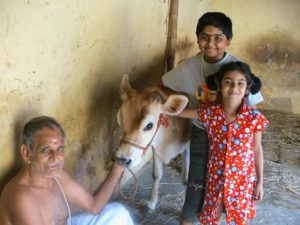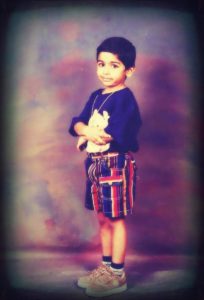Culture Shock Experience – Global Classroom

Vikram Seshadri moved to Cincinnati from Chennai, India in August of 2017 to study at the University of Cincinnati. He graduated this past December with a Masters in Electrical Engineering. Back in India, he was involved with various cultural organizations including SPICMACAY (The Society for the Promotion of Indian Classical Music and Culture Amongst Youth), a volunteer youth movement that promotes Indian cultural heritage through classical music and dance. He has a true passion for cooking and music, as he loves preparing traditional Indian cuisine and playing the flute.
During his time in Cincinnati, Vikram volunteered at the World Affairs Council by donating his time working with young students through the Global Classroom Program as a Global Guide. Vikram has presented his home country of India, highlighting the arts, literacy, food, music, and architecture to our local students. These face to face interactions allow students to benefit from a genuine connection to cultural diversity and inclusion. In this blog, Vikram reflects on his previous presentations while offering advice to future and current Global Guides.
Can you discuss your first presentation as a Global Guide? What did you learn from this experience?
Over the course of last year, I had many opportunities to present my home country to elementary students across Cincinnati and Northern Kentucky. My first presentation was held at Summit View Elementary located in Independence, Kentucky, where I presented to 150 third grade students on the topic of Indian culture and invalidated a few stereotypes. This was an intriguing experience for me because I learned even more about myself, my culture, and public speaking.
#1: Know your audience – The presentation I prepared was filled with pictures and animations to grab the student’s attention. These third-grade students were in awe and very receptive to the interactivity of the presentation. If presenting to adults, I would modify the same presentation in order to focus on more hard facts and data.
#2: Be ready for any questions – Even though this presentation was made specifically for children to understand, they had a lot of questions I never expected I had to answer. Some questions that took me by surprise. “When someone hits you in what language do you scream and what do you scream?” “How is my name pronounced in your language?.”
They found it interesting that cows are a part of the family in a traditional home in India. One student asked, “Who owns the cows walking on the streets?” It was fascinating to see how their thought process worked as such young learners. I was unable to answer a few questions because honestly, I did not have an answer for them.
 What advice would you give other Global Guides when speaking to children on cultures they may be unfamiliar with?
What advice would you give other Global Guides when speaking to children on cultures they may be unfamiliar with?
I would suggest that Global Guides give the students a comparative study of the culture being presented to the American culture so they can better understand the similarities and differences. I would also suggest a large usage of images rather than words, so the students stay engaged. It is amazing to see their excitement when they look at the unique pictures so different from their own culture. For the students to relate to you, I would recommend adding pictures of yourself doing activities significant in your culture at their current age.
What is one characteristic you think every Global Guide or even speaker should possess?
Enthusiasm is one of the main characteristics needed for anyone addressing people from different cultures. The ability to connect with the audience is an important characteristic all presenters should keep the topic interesting and informative.
What surprised you most about the children during your presentation?
I didn’t expect it to be so difficult to keep the young audience focused on the presentation. The students had so much energy that they could not sit still. It did surprise me that every student was able to relate to each topic and provide examples of similar experiences they had. The most surprising factor was all the questions I got in the end, each Global Guide needs to be prepared for any question.
What is your favorite cultural topic to present?
I particularly enjoy talking about food and music, mainly because I cook a lot and play the flute. It is something I can relate to on a much deeper level. Comparing cultural and regional cuisines provides an interesting perspective toward the unique types of entertainment and dining experiences each culture embodies.
Indian cuisine is my favorite topic because we use a ton of spices. Even when you follow the same recipe the dish can take a variety of flavor profiles. The staple diet of India which mainly consists of rice, wheat, and lentils is one of the reasons why 70% of the population in India are vegetarians. The reason for this is also because of religious and cultural norms. Many worship animals as gods which prevent the population from eating meat hence the huge vegetarian population.
As a vegetarian, I have a hard time eating out, as the options are very limiting here in the United States to explore different cuisines. When I first moved here, I began taking a deeper dive into the cooking universe. When I begin preparing a dish, I don’t have a game plan, adding in at least 10 different spices to my meal changes a dish dramatically, amazing myself and the people I dine with.
One of my favorite dishes to make would be Vegetable Pulao. It is a simple dish with rich flavors and highly nutritious vegetables. I add multiple spices just for the flavor and a few more just for the color. It can be made with as many vegetables as possible, but I usually add at least 4 to 5 (onions, peas, carrots, tomatoes, cabbage). We live in a fast-paced world, so sitting down for a proper and delicious meal always makes my day and helps me face this world with my tummy full and a smile on my face. Thank you to the World Affairs Council – Cincinnati and Northern Kentucky for the wonderful opportunities as a Global Guide volunteer. I can already see how these presentations have helped me learn more about my own culture and others. As an Engineer, I feel we are in a shell of advancing technology with minimal human interaction. I would love to be able to connect with fellow engineers the same way I did with these young students.


